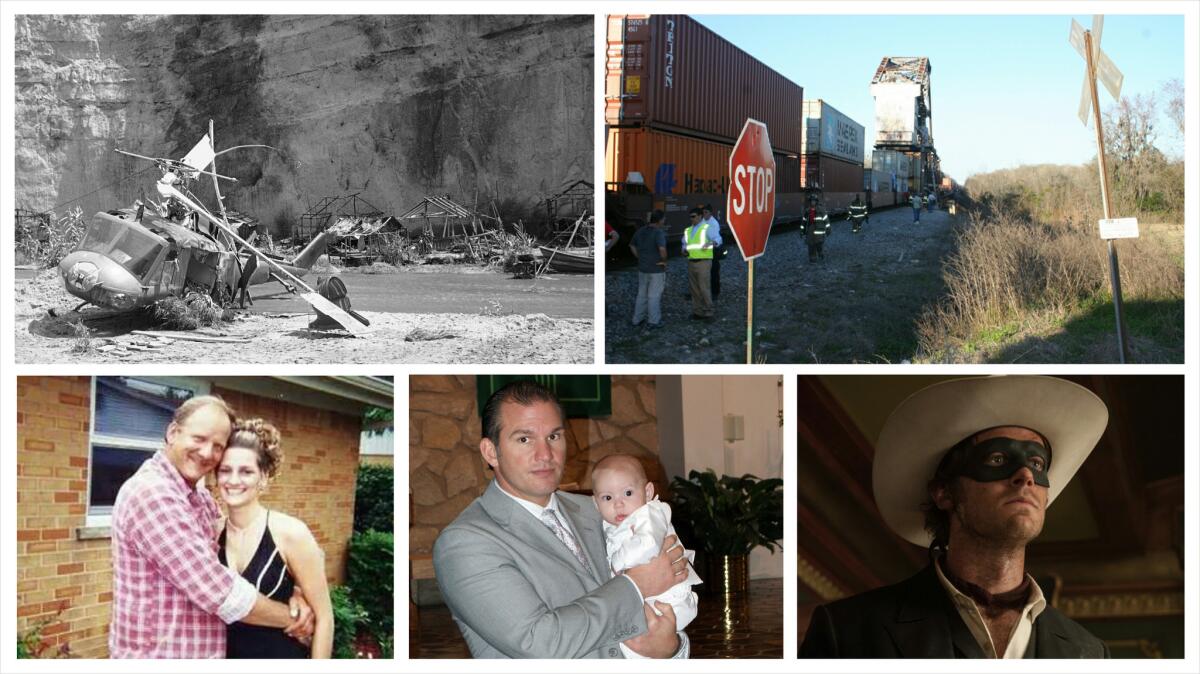As deaths rise on reality TV, film sets, many blame need to get ‘dramatic footage’

Unscripted action adventure shows have become a staple of the entertainment industry, and the helicopter collision that claimed 10 lives this week on a set in Argentina underscored the risks in reality television.
Nearly one-third of all fatalities on film and TV shoots over the last five years have involved reality shows, according to a Los Angeles Times review of U.S. government data. There were 20 deaths related to motion picture and television production for the five years that ended in December 2014, double the number of fatalities during the previous five-year period.
The increase occurred as workplace fatalities in the private sector overall declined 4%, according to the federal Bureau of Labor Statistics, which compiles injury data from coroner’s reports, workers’ compensation claims and other sources.
Deaths have occurred on soundstages and location shoots, on big-budget Hollywood blockbusters as well as small independent productions, the records show.
But reality TV shows — especially ones that highlight danger — have added risks, industry safety experts say, because producers need dramatic footage to compete for viewers in an increasingly crowded field.
In this atmosphere, safety can take a back seat to ratings, said Angela Plasschaert, a Los Angeles-based risk management consultant who works with film producers and insurance companies to assess risks and develop safety programs.
“The attitude is, ‘Do what you’ve got to do, but don’t get in the way,’” she said of some of her clients.
The cause of Monday’s crash in Argentina — the deadliest yet in connection with a reality TV show — is under investigation. It occurred when two helicopters collided in midair during the filming of the series “Dropped” for French TV, in which participants are abandoned in the wilderness and must find their way back to civilization.
Helicopters were also involved in two of the worst U.S. filming accidents in recent decades — a 2013 crash in Acton for a reality TV show that killed three people, and the 1982 “Twilight Zone: The Movie” crash near Santa Clarita that killed actor Vic Morrow and two children.
Safety investigators say Hollywood producers often fail to take proper precautions.
“It’s truly remarkable to me that production companies can use ultra-advanced technology to make spectacular films but too often they won’t spend the modest resources necessary to make sure their workers are not injured or killed on the job,” said David Michaels, assistant secretary of Labor for the Occupational Safety and Health Administration.
Film- and TV-related fatalities steadily declined in the 1990s, and dropped to none by 2003, as studios and producers stepped up their safety efforts and as some risky stunts were replaced with digital effects.
In the last five years, however, the number of fatalities has risen, federal records show. Authorities put at least some of the blame on shortcuts taken by producers to save time and money.
“Often when we investigate fatalities, we find that they were predictable and preventable,” Michaels said. “They often involved cutting corners, hurrying things up to save money or both and the result is tragedy.”
Prosecutors say skirting basic safety rules was behind a 2014 film set tragedy in Georgia, when 27-year-old camera assistant Sarah Jones was killed and seven others were injured when a freight train hit the crew filming “Midnight Rider,” a movie about the life of rocker Gregg Allman.
The film’s director, Randall Miller, pleaded guilty to involuntary manslaughter Monday and was given a two-year prison sentence, the first of its kind in Hollywood history. On Tuesday, the assistant director, Hillary Schwartz, was sentenced to 10 years of probation after being found guilty of involuntary manslaughter and criminal trespass.
Authorities found dozens of safety violations in the wake of the 1982 “Twilight Zone” tragedy and charged director John Landis and four others with involuntary manslaughter. The defendants were all acquitted.
The 2013 chopper crash in Acton occurred during filming of a planned Discovery Channel military show with the working title of “Lone Operator.” The helicopter was flying close to the ground when it hit a slope, killing cameraman Darren Rydstrom, 45, of Whittier; cast member Michael Donatelli, 45, of Indiana, Pa.; and the pilot, David Gibbs, 59, of Valencia.
Records show that Gibbs did not have permission from the Federal Aviation Administration to fly in the early morning hours when the accident occurred. Gibbs had his pilot’s license suspended twice, including in 2003 over an incident in which he piloted a helicopter that flew into a power line as a crew was filming an episode of “Ripley’s Believe It or Not!” near Kingman, Ariz., according to a National Transportation Safety Board report.
Donatelli was a former Special Forces member and decorated Iraq war veteran. After retiring from the military in 2009, he launched his own security consulting firm in Pennsylvania when an old Army buddy contacted him about working on “Lone Operator.” Donatelli was acting as a consultant and narrator.
“He was really excited about it,” said his widow, Grisel Donatelli. “It was the happiest I’d seen him since he retired.”
She spoke to her husband the day before he died. “He had just finished shooting and he was exhausted. His last words were, ‘I love you baby. I’ll call you tomorrow.’”
Since the accident, Donatelli said she has struggled to support her five children. Michael Donatelli’s family in 2013 filed a wrongful death lawsuit in Los Angeles Superior Court against the producers, including Discovery and other companies, alleging that they did not take adequate safety measures and were negligent in hiring Gibbs.
Discovery and the other defendants have disputed the claims. A spokeswoman for Discovery declined to comment.
Fatal injuries, however, haven’t been confined to reality shows or low-budget productions like “Midnight Rider.”
On the same Acton ranch where Donatelli and his colleagues were killed, 48-year-old diver Michael Bridger drowned five months earlier. The Redondo Beach resident was cleaning a 24-foot-deep water tank to be used in an underwater scene for the Walt Disney Studios’ movie “The Lone Ranger,” a big-budget western starring Armie Hammer and Johnny Depp.
State regulators fined the film’s producer, Silver Bullet Productions, more than $60,000 for serious violations, including not having a standby driver available, not providing a medical examination to determine an employee’s fitness to dive and not having a dive master to oversee the work.
A year earlier in New Orleans, Michael Huber, a 54-year-old set builder, died when a scissor lift he was operating tipped over as he was maneuvering it down a ramp. Huber was dismantling a set for Paramount’s “G.I. Joe: Retaliation.”
OSHA fined Paramount $21,000 for two “serious” violations, saying that Huber was not trained to operate the equipment and that the lift was operating too fast.
A contractor from Detroit, Huber had moved to Louisiana after a divorce to rebuild homes after Hurricane Katrina. As Louisiana’s film business took off, Huber was hired to build sets for “The Twilight Saga” movies and “Abraham Lincoln: Vampire Hunter.”
“He found the whole thing fun and fascinating,” said his daughter, Eryn Huber, a dental student in Michigan. “He was a very outgoing person and loved to able to meet different people.”
Huber was close to her dad, who encouraged her to attend dental school. Four years after his death, she remains sad and angry. She said the family wanted to sue, but couldn’t because Michael Huber had signed a legal waiver with Paramount.
“My dad should not have been operating the equipment on a ramp at that speed,” Huber said. “It was definitely preventable.”
“They need to step up and make things safer to prevent this from happening to another family,” she said, referring to OSHA.
Paramount declined to comment.
Times staff writer Doug Smith contributed to this report.
More to Read
From the Oscars to the Emmys.
Get the Envelope newsletter for exclusive awards season coverage, behind-the-scenes stories from the Envelope podcast and columnist Glenn Whipp’s must-read analysis.
You may occasionally receive promotional content from the Los Angeles Times.









